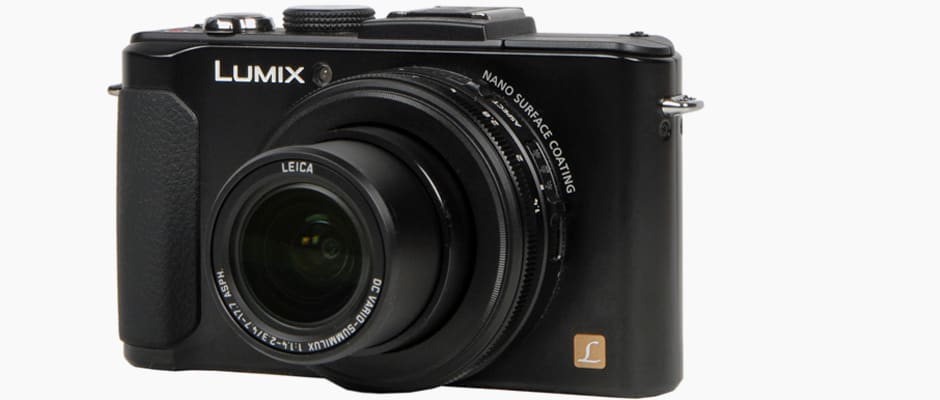Pros
Cons
Introduction
The LX7 is Panasonic's latest high-end offering, packing an f/1.4-2.3, 3.8x zoom lens, backed by a slightly over-sized 1/1.7-inch 10-megapixel MOS sensor. We spent a few minutes with the LX7 at a briefing last month. Read on for our impressions of how it might fare in this revitalized segment.
As usual with Panasonic, pricing and launch date will be announced when they're ready to announce them, but if history teaches us anything, it should be $499 and hit shelves in late summer or early fall, available in black or white.
Design & Appearance
{{section_header}}{{section.name}}{{/section_header}}
The LX7 looks like a serious camera, available only in black, with plenty of toggles and switches for hands-on control. The aspect-ratio switch on the lens ring is the feature that most sets it apart from other high-end compacts. The lens ring controls the aperture, which gives it a pseudo-retro look and feel, but it comes across as a bit contrived.
Tour
{{section_header}}{{section.name}}{{/section_header}}




Menu
{{section_header}}{{section.name}}{{/section_header}}
The LX7's menu system received a nice facelift, with more eye-pleasing background and sharper text than previous models. Functionally, though, the menu is pretty much the same. The setup is logical, but not always great for speedy adjustments. The quick menu system is more appropriate for on-the-fly changes, though some extra hot keys or function buttons would help even more.
Ease of Use
{{section_header}}{{section.name}}{{/section_header}}
iAuto mode is available and surely effective for quick snapshots. But the LX7 is meant for hands-on users who will take advantage of its depth of control. There are probably better options for novices, even those who want superior image quality in a pocket-sized package.


Size & Handling
{{section_header}}{{section.name}}{{/section_header}}
Panasonic designed the LX7 with convenience in mind more than comfort. Handling isn't bad; it's light enough to carry but solid enough to sit in your hand, but there just isn't much to hang on to. It's certainly small enough to fit into a pants pocket, though it comes with a neck strap.


Modes Overview
{{section_header}}{{section.name}}{{/section_header}}
The LX7 has a pretty standard mix of shooting modes. iAuto takes the reins, but PASM modes, many scene presets, plenty of filters, and a 1080/60p movie mode (with full manual control) are all available.

Auto Mode
{{section_header}}{{section.name}}{{/section_header}}

Movie Mode
{{section_header}}{{section.name}}{{/section_header}}
Movies can be recorded at 1080/60p in the AVCHD 2.0 format, or at 1080/30p in MP4 format.
Drive/Burst Mode
{{section_header}}{{section.name}}{{/section_header}}
Burst mode tops out at a mighty 11 frames per second. With autofocus enabled, that figure drops by about half. Either way, that's very speedy shooting, right up there with the fastest cameras.
Custom Image Presets
{{section_header}}{{section.name}}{{/section_header}}
Two custom image presets are available on the mode dial.
Picture Quality & Size Options
{{section_header}}{{section.name}}{{/section_header}}
Resolution maxes out at 10.1 megapixels in a 4:3 aspect ratio. It also captures in 16:9, 3:2, and 1:1 formats. RAW and RAW+JPEG capture are supported, and two JPEG compression levels are available (Normal and Fine).
Focus
{{section_header}}{{section.name}}{{/section_header}}
It's probably marketing more than anything, but Panasonic claims that they've ported the Light Speed AF system from the G series to the LX7. In the brief time we spent with the camera, it was fast, though we didn't have a chance to test it in dim settings. Manual focus is also available, though it's usually hit-or-miss with compacts like this.
ISO
{{section_header}}{{section.name}}{{/section_header}}
Sensitivity ranges from ISO 100 through 12800, though at the top setting, it seems to use a multi-shot noise-reduction setting. It's user adjustable in full stops or 1/3 EV stops.
Image Stabilization
{{section_header}}{{section.name}}{{/section_header}}
The LX7 features Power O.I.S. stabilization. With such a bright aperture throughout the focal range, you might not need it, but it can't hurt to have it.
Picture Effects
{{section_header}}{{section.name}}{{/section_header}}
14 picture effects are available in Creative Control mode (as Panasonic calls it), including Soft Focus, Dynamic Monochrome, Impressive Art, One Point Color, Cross Process, Low Key, Toy Effect, Star Filter, Expressive, Retro, High Key, Sepia, High Dynamic, Miniature Effect.
Other Controls
{{section_header}}{{section.name}}{{/section_header}}
ND Filter
The LX7 has a dedicated switch to enable a neutral-density filter. In a nutshell, it prevents skies from being blown out.
Lens & Sensor
{{section_header}}{{section.name}}{{/section_header}}
Lens
The f/1.4-2.3, 24-90mm lens is one of the headline features on the LX7. The maximum aperture is incredibly bright, and even at the telephoto setting, it's still faster than most cameras are at their best. The 3.8x zoom is short by today's standards, but not so skimpy in the context of the high-end compact class. It has a nano-surface coating as well, though it's never easy to predict the real-world benefits.
Sensor
The LX7 is built around a 10-megapixel, 1/1.7-inch MOS sensor. It's a jump up from the CCD chip in its predecessor, the LX5. The size is traditional for this class, in line with cameras like the Canon S100, Olympus XZ-1, and the new Samsung EX2F. But it's notably smaller than the 1-inch sensor in the Sony RX100, which has the camera world buzzing.

LCD
{{section_header}}{{section.name}}{{/section_header}}
The LX7 has a 3-inch, 920,000-pixel LCD on the rear. It seemed bright and vibrant and crisp in the time we spent with it, and the specs are certainly nice. We weren't able to test it under bright sunlight, though.

Flash
{{section_header}}{{section.name}}{{/section_header}}
The flash slides straight up out of the body, controlled with a physical release, and is effective to a decent 8.5 meters. It has a hot-shoe accessory port as well, which (we think) can support an external flash for more power.

Jacks, Ports & Plugs
{{section_header}}{{section.name}}{{/section_header}}
Like most cameras these days, the LX7 has USB and mini-HDMI jacks.


Battery
{{section_header}}{{section.name}}{{/section_header}}
The rechargeable lithium-ion battery in the LX7 is CIPA-rated for 330 shots per charge, which is quite good, though not quite outstanding.

Memory
{{section_header}}{{section.name}}{{/section_header}}
Guess what? The LX7 records to SD/SDHC/SDXC media cards.

Conclusion
Let's that the Panasonic LX7 was announced three months ago, in April 2012 instead of July 2012. Everything else is otherwise the same.
The LX7's lens is incredibly bright, starting at an insane f/1.4 and tapering off to a still-excellent f/2.3. The 10-megapixel, 1/1.7 MOS sensor is the same size and type as the sensors in the best high-end compacts. The feature set is excellent, with 1080/60p video and 11fps bursts. And of course, it has a great interface and tons of control. That's an excellent camera, just what enthusiasts want in a high-end compact, and they're all stoked.
In real life and real time, excitement around the LX7 is tempered by the existence of the Sony RX100. It's hard to argue with a larger sensor and a still-bright lens (though it shrinks to f/4.9 at the telephoto setting), especially when the camera seems to get everything else right too. And then there's the Samsung EX2F, another new 1/1.7-inch compact with an f/1.4 lens.
The LX7 still looks like it'll be a solid high-end compact; Panasonic just didn't take the right risk this time (Sony's move was a bold one, actually). We'll have to see how the image quality stacks up when we get it into our labs. But if too many awesome compacts to choose from is a problem, it's a good problem to have.
{{product.vanity}}
Sample Photos
{{section_header}}{{section.name}}{{/section_header}}
Specs
{{manufacturer_specs_table}}
Meet the tester
Liam manages features and news coverage for Reviewed.com. Formerly the editor of the DigitalAdvisor network, he's covered cameras, TVs, personal electronics, and (recently) appliances. He's a native Bostonian and has played in metal bands you've never heard of.
Checking our work.
Our team is here to help you buy the best stuff and love what you own. Our writers, editors, and experts obsess over the products we cover to make sure you're confident and satisfied. Have a different opinion about something we recommend? Email us and we'll compare notes.
Shoot us an email

